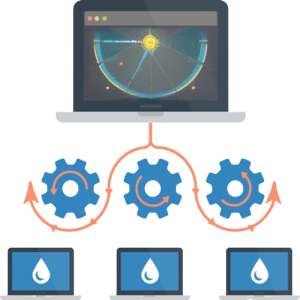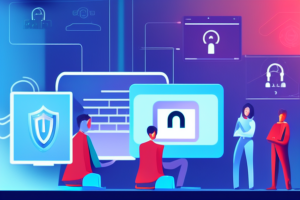Vulnerability Management
Vulnerability management is a process of identifying, assessing and mitigating potential risks and vulnerabilities in IT systems. It is important because it ensures a company’s IT security and data protection and protects against cyberattacks, data loss and other threats. Invest in a robust vulnerability management system to strengthen your IT infrastructure and protect your business from potential risks.

Vulnerability management is an important process in the field of IT security in which potential risks and weaknesses in IT systems are identified, assessed and mitigated. A vulnerability management system helps organizations strengthen and protect their IT infrastructure by identifying and addressing potential threats before they can lead to disaster.
First, it is important to understand what a vulnerability is. A vulnerability is a flaw or incompleteness in an IT system that allows attackers to exploit the systems to cause harm. These attacks can take the form of cyberattacks, data theft, or other threats. A vulnerability management process is required to identify and address these vulnerabilities.
The vulnerability management process is multi-step. First, potential vulnerabilities are identified. The vulnerabilities are then assessed and prioritized to determine which ones need to be addressed most urgently. After the assessment, countermeasures are implemented to address and close the vulnerabilities. Finally, the system is regularly monitored and reviewed to ensure that no new vulnerabilities arise.
A robust vulnerability management system helps ensure your company’s IT security and data protection. It helps identify and address potential threats before they become a major problem.

Selected security measures
Safety is not a matter of chance – with us it’s standard. In addition to securing personal data through
Dark Web Scans
, we offer numerous other technical security solutions.

The importance of vulnerability management
Vulnerability management is of utmost importance to your organization as it helps them identify and mitigate potential risks and threats to their IT systems and data. Here are some of the top reasons why effective vulnerability management is so important:
Preventing cyberattacks: Perhaps the most important reason why vulnerability management is so important is to prevent cyberattacks. By identifying and addressing potential vulnerabilities, together we can prevent hackers from gaining access to critical data and systems.
Protecting confidential data: An equally important reason why vulnerability management is so important is the protection of confidential data. By identifying and eliminating vulnerabilities, you can prevent data from being stolen or misused.
Preventing data loss: Another important aspect of vulnerability management is preventing data loss. By monitoring systems and fixing vulnerabilities, your organization can ensure that important data is not lost.
Maintaining IT security: A robust vulnerability management system helps your company maintain and strengthen IT security. By monitoring systems and eliminating vulnerabilities, you can thus ensure that you are protected against cyberattacks and other threats.
Compliance with legal requirements: Many companies must comply with legal requirements in the area of data protection and IT security. By implementing effective vulnerability management, you can demonstrate that you meet these requirements.

external service providers for your vulnerability management
Some important reasons why companies should hire an external service provider are:
Competence and experience: External service providers such as Panomity GmbH have extensive experience and expertise in vulnerability management and can therefore identify and eliminate risks more effectively and quickly.
Independence: An external service provider is independent of a company’s internal processes and can therefore work more objectively and effectively.
Cost-efficiency: It can be more cost-effective to hire an external service provider than to task your internal IT department with vulnerability management, tying up valuable resources for you. An external service provider can often work faster and more efficiently and has access to the latest tools and technologies.
Regular monitoring: An external service provider regularly monitors vulnerability management and ensures that potential risks and threats are identified and remediated at an early stage.
Protection from legal consequences: Effective vulnerability management can protect your company from legal consequences resulting from data leaks or cyber attacks.

Vulnerability management as a shield for your reputation
Reputation is an important aspect of business and can suffer due to vulnerabilities in IT systems. Cyberattacks, data leaks, and other threats that arise due to unprotected vulnerabilities can severely damage customer trust in a company. Robust vulnerability management can prevent this by identifying and addressing potential risks and vulnerabilities before they become a problem.
A good example is the 2019 data leak from U.S. credit card company Capital One. The hackers exploited a vulnerability in the company’s firewall configuration to steal sensitive customer data such as names, addresses and credit card numbers. This resulted in damage to the company’s image and a loss of customer confidence.
On the other hand, if companies invest in effective vulnerability management, they can identify and address potential risks and threats at an early stage. This helps them strengthen their IT infrastructure and protect their reputation. A company with a good reputation is seen as trustworthy by customers and can take advantage of better business opportunities. Therefore, effective vulnerability management is an important factor for the long-term success of a company.

Our cooperation with your EDP
As an external vulnerability management service provider, we work with your company’s internal IT by using tools and technologies to identify potential vulnerabilities in the network and systems. These tools regularly scan your systems to detect and assess vulnerabilities. The results are transmitted in the form of reports to your company’s internal IT, which then goes through these reports and works through the weaknesses found.
It may happen that false positives are reported during the scans, i.e. vulnerabilities are reported that in reality are not. In this case, we need to work with your IT to document these false positive vulnerabilities so that we can adjust our scanning tools accordingly to avoid such misdiagnoses in the future.
Please keep in mind that Panomity GmbH, as an external service provider, not only helps to ensure that your company’s IT systems and networks are more secure through the scans, but also that your company stays up-to-date with the latest technology and is always informed about current threats.
Security ensured, vulnerabilities combated – Our vulnerability management protects you!
Protection against threats: Increase your IT security with our vulnerability management.
With us as your vulnerability management partner, you’ll feel safer than you would in a vault door. Our decades of experience in dealing with hackers guarantees the best possible security for your company. With our continuous monitoring and effective vulnerability management, you can rest assured that your data and systems are protected around the clock – as robust and reliable as a vault door.

Identification of vulnerabilities
The vulnerability identification process roughly follows the following pattern:
Agreement: First, an agreement is reached between your company and us as your external service provider, defining the goals and expectations of vulnerability management.
Scan Configuration: We configure our scan tools to scan your organization’s network and systems. For this purpose, your company activates IP addresses named by us for extended access. The configuration can be adapted to the specific requirements of your company, e.g. to specific systems or networks.
Scan execution: We perform regular scans to identify potential vulnerabilities.
Scoring: The results of the scan are scored to determine the severity of each vulnerability found.
Report: We prepare a report summarizing the vulnerabilities found and describing the steps required to address them.
Transmission: The report is transmitted to your company’s internal IT system, which processes the vulnerabilities found.
Monitoring: We monitor the systems to ensure that vulnerabilities have been successfully addressed.
This is a generally described process for vulnerability management by Panomity GmbH as your service provider. The exact process may vary depending on the requirements of your business, but the basic principle remains the same: regular scans, assessment of the vulnerabilities found, and monitoring of the elimination of these vulnerabilities.

Vulnerability assessment and prioritization
Vulnerability assessment and prioritization refers to how dangerous a vulnerability is to a company’s IT system and how quickly it needs to be fixed. For this, various factors are taken into account, such as:
Severity: This evaluates how serious a vulnerability is to the system, e.g., whether it allows data to be lost or sensitive information to be accessed.
Exploitability: This is about how easily a vulnerability can be exploited.
Distribution: This looks at how widespread a particular vulnerability is and how many systems could be affected by it.
System Priority: This assesses how important a particular system is to the organization and how urgently it needs to be protected.
Based on these factors, vulnerabilities are prioritized and a plan is created to address the most serious issues. It is important that scans are performed regularly and that vulnerabilities are fixed quickly to guarantee high IT security and data protection.

Continuous review
A one-time vulnerability scan is not enough to fully protect a company’s IT system. Hackers, cyber criminals and other threats are constantly active and looking for new ways to penetrate IT systems. Therefore, vulnerability management must be a continuous process, with IT systems regularly reviewed to ensure that no new vulnerabilities emerge.
Continuous monitoring includes regularly checking for software updates, patches and new threats to ensure that the IT system is always up to date and protected against attacks. It is important that regular reviews are conducted to ensure that new vulnerabilities are identified and mitigated before they can be exploited by hackers.
In short, ongoing vulnerability management is critical to protecting an organization’s IT system and ensuring that no new vulnerabilities emerge that could increase the risk of a cyberattack.

Software assisted management
Vulnerability management can be supported by the use of a specialized software solution. This software makes it possible to automatically scan IT systems for potential risks and vulnerabilities and to perform assessments and prioritizations. In addition, the software can recommend countermeasures and facilitate continuous monitoring and review. To make vulnerability management effective and efficient, it makes sense to use such a software solution.

Overcoming cognitive safety dissonance.
Experience shows that companies only look for a solution for continuous vulnerability management after they have been the victim of a cyber attack. This is due to cognitive dissonance.
Cognitive dissonance refers to a mental conflict that occurs when someone has two or more inconsistent beliefs, opinions, or actions. In the context of companies and their IT, this means that on the one hand they believe they have the necessary skills and resources to ensure IT security and data protection internally, but on the other hand they are operating in an extremely insecure environment on the open Internet and still have potential vulnerabilities in their systems.
This cognitive dissonance can cause companies to ignore their concerns and issues and not act to address them. However, this can lead to serious security breaches and increase the risk of cyberattacks, data loss and other threats. To ensure effective vulnerability management, it is important that organizations review their beliefs and be prepared to seek external support when necessary.
Frequently asked questions about vulnerability management
Why should Panomity GmbH take over our vulnerability management?
Our staff has decades of experience working with hackers and collaborating with individuals from the U.S. intelligence community and has a deep understanding of the threats and attack techniques that organizations face. This allows us to proactively address potential vulnerabilities and ensure that your business is protected from potential attacks. In addition, we service providers may have access to state-of-the-art tools and technologies that are not otherwise available, as well as a network of experts who can be consulted as needed. ;-) Therefore, as a service provider, we are able to take over the vulnerability management of your company more effectively and safely than other service providers who do not have comparable experience and expertise.
What vulnerabilities can be captured?
Our vulnerability management offers comprehensive vulnerability scanning that features unparalleled quality and accuracy. Our scan covers over 100,000 vulnerability tests that are constantly updated based on the latest CVEs, vendor advisories and other sources. We ensure the highest and measurable quality of both remote and authenticated detection and provide rapid availability of testing for newly discovered vulnerabilities. In addition, we use additional undisclosed vulnerability management tools at our discretion to ensure the most thorough and reliable protection possible. Our scans also comply with CIS benchmarks and IT baseline protection guidelines, and offer both generic and custom scan configurations for maximum flexibility and tailored results. Strengthen your organization’s cyber defenses with the most trusted and comprehensive vulnerability scanning solution on the market.
Is vulnerability management required by law?
For companies in the EU, a legal requirement for vulnerability management can be derived from the EU General Data Protection Regulation (GDPR). The GDPR requires companies to take appropriate technical and organizational measures to ensure that personal data is protected. Effective vulnerability management is a necessary measure to achieve this, as it helps organizations identify and assess potential threats and take action to address them. Through vulnerability management, companies thus fulfill their obligation to adequately protect personal data, as required by the GDPR.
What is vulnerability management for?
Vulnerability management is a process that aims to identify, assess and eliminate potential risks and vulnerabilities in IT systems. It is used to ensure a company’s IT security and data protection and to protect against cyber attacks, data loss and other threats.
Why should a company invest in a vulnerability management system?
A company should invest in a vulnerability management system to strengthen its IT infrastructure and protect itself from potential risks. This is important to prevent potential data loss or cyberattacks, and to maintain the company’s reputation and trust.
Why is it important to hire an external vulnerability management service provider?
An external service provider can help a company identify and eliminate potential weaknesses more effectively. He also brings independent and competent assessments, extensive know-how and experience in dealing with vulnerabilities in various systems.
How are vulnerabilities assessed and prioritized?
Vulnerabilities are assessed and prioritized based on their severity and impact on the IT system. This includes assessing the potential risk posed by a vulnerability and prioritizing the remediation of that vulnerability based on how urgently it needs to be addressed.
What are the best practices for effective vulnerability management?
Best practices for effective vulnerability management include regular monitoring and review, documentation, regular training and awareness programs, continuous monitoring and review, and the use of an automated software solution.
What are the main objectives of vulnerability management?
The main objectives of vulnerability management are to identify, assess and remediate potential risks and vulnerabilities in IT systems in order to ensure the company’s IT security and data protection and to protect it from cyberattacks, data loss and other threats.
What is continuous vulnerability management?
Continuous vulnerability management refers to the ongoing process of monitoring and reviewing IT systems for vulnerabilities. It is important because new threats and vulnerabilities are continuously emerging (on a daily basis) and it is necessary to constantly detect and remediate them to ensure the company’s IT security.
